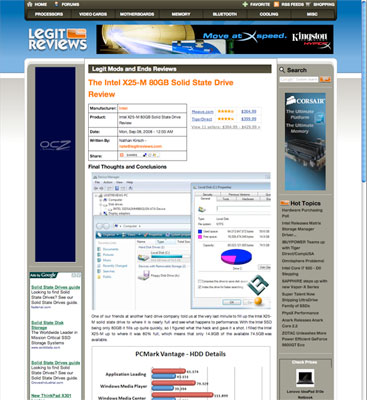The SSD Anthology: Understanding SSDs and New Drives from OCZ
by Anand Lal Shimpi on March 18, 2009 12:00 AM EST- Posted in
- Storage
Hey, There’s an Elephant in the Room
When the first X25-M reviews went live a few people discovered something very important, something many of us (myself included) missed and should’ve addressed: the drive got slower the more you filled it up. It’s no great mystery why this happened, but it seemed odd at the time because it went against conventional thinking.

LegitReviews was one of the first to spot the SSD slowdown phenomenon, good work Nate.
It’s worth mentioning that hard drives suffer from the same problem; just for a different reason.
Hard drives store data on platters; the platters rotate while an arm with read/write heads on it hovers over the surface of the platter and reads data while the platter spins. The diameter of the platter is greater the further out on the platter you go, that’s just how circles work. The side effect is that for the same amount of rotation, the heads can cover more area on the outside of the platter than on the inside.
The result is that transfer speeds are greater on the outer sectors of the platter than on the inner ones. OSes thus try to write as much data to the outer sectors as possible, but like beachfront property - there’s only a limited amount of space. Eventually you have to write to the slower parts of the drive and thus the more full your drive is, the slower your transfer rates will be for data stored in the innermost sectors.
Fragmentation also hurts hard drive performance. While modern day hard drives have gotten pretty quick at transferring large amounts of data stored sequentially, spread the data out all around the platter and things get real slow, real fast.
Randomness is the enemy of rotational storage.
Solid state drives aren’t supposed to have these issues. Data is stored in flash, so it doesn’t matter where it’s located, you get to it at the same speed. SSDs have +5 armor immunity to random access latency (that’s got to be the single most geeky-sounding thing I’ve ever written, and I use words like latency a lot).
So why is it that when you fill up a SSD like Intel’s X25-M that its performance goes down? Even more worrisome, why is it that when you delete data from the drive that its performance doesn’t go back up?
While SSDs are truly immune to the same problems that plague HDDs, they do also get slower over time. How can both be true? It’s time for another lesson in flash.










250 Comments
View All Comments
strikeback03 - Thursday, March 19, 2009 - link
If you get Newegg's specials, one of the codes is for the 30GB for $103 with a $20MIR, so $83 with shipping if the rebate comes through. At the size I would want (~120) the Super Talent undercuts the OCZ slightly.Does anyone know if you can install the firmware of one maker to another maker's SSD? For example, assuming both the Ultradrive ME and the Vertex use the same Indilinx controller, and say Super Talent chose to release it with the firmware which optimizes for higher sequential speeds, would the user be able to choose the firmware which optimizes for less latency?
Testtest - Wednesday, March 18, 2009 - link
Ah, no editing?!A-Data's "300 plus" SSD also uses the Indilinx controller.
vailr - Wednesday, March 18, 2009 - link
"The Anatomy of a SSD" should instead read: "The Anatomy of an SSD"Flunk - Wednesday, March 18, 2009 - link
Yes, because S is a vowel...abudd - Wednesday, March 18, 2009 - link
Assuming SSD = "es-es-dee" then "an SSD" is right. If it *sounds* like a vowel, use "an".JarredWalton - Wednesday, March 18, 2009 - link
Yes, *but* SSD could also be read as "Solid State Drive" instead of "ess ess dee", in which case you would say "a SSD". I tend to read it as "ess ess dee", but Anand thinks of those letters as "Solid State Drive".Potato, potato, tomato, tomato... let's call the whole thing off!
Azsen - Thursday, March 19, 2009 - link
When reading acronyms you're supposed to think of them as the letters, i.e. when you see RAM, you think "ram" straight off not Random Access Memory. When you see "IBM" you think "eye bee emm" not International Business Machines etc etc. It would take ages to read an article if you had to stop and think out all the full wording of acronyms as you're reading them.I'm going with the correction of "Anatomy of an SSD". Correct English fullstop.
JarredWalton - Thursday, March 19, 2009 - link
By your comment, you suggest two different things, and that's really okay. That was my point: when you see "RAM" you probably thing "ram" as in the animal... not "Are A Em". You say "a RAM stick" not "an RAM stick". I'd guess most people think of SATA as "Ess A Tee A", but if you talk to most computer techs that are in the know, it's "say-te" so you would say "a SATA drive".And you know, I'm sure plenty of people will agree with the correct way of saying SATA, and that's perfectly okay. English really is a very flexible thing - particularly in the tech world - and rarely is there an "always right" way of saying things. If Anand wants to say "a SSD" and others want to say "an SSD", I'm not going to try to declare one group or the other correct. They both are, depending on your viewpoint.
"I believe the world is neither black nor white, but only shades of gray."
Pythias - Friday, March 20, 2009 - link
Can't have gray without black and white.7Enigma - Wednesday, March 18, 2009 - link
HAHAHA. What a tool. I love it when people critique grammar.....and get it wrong.